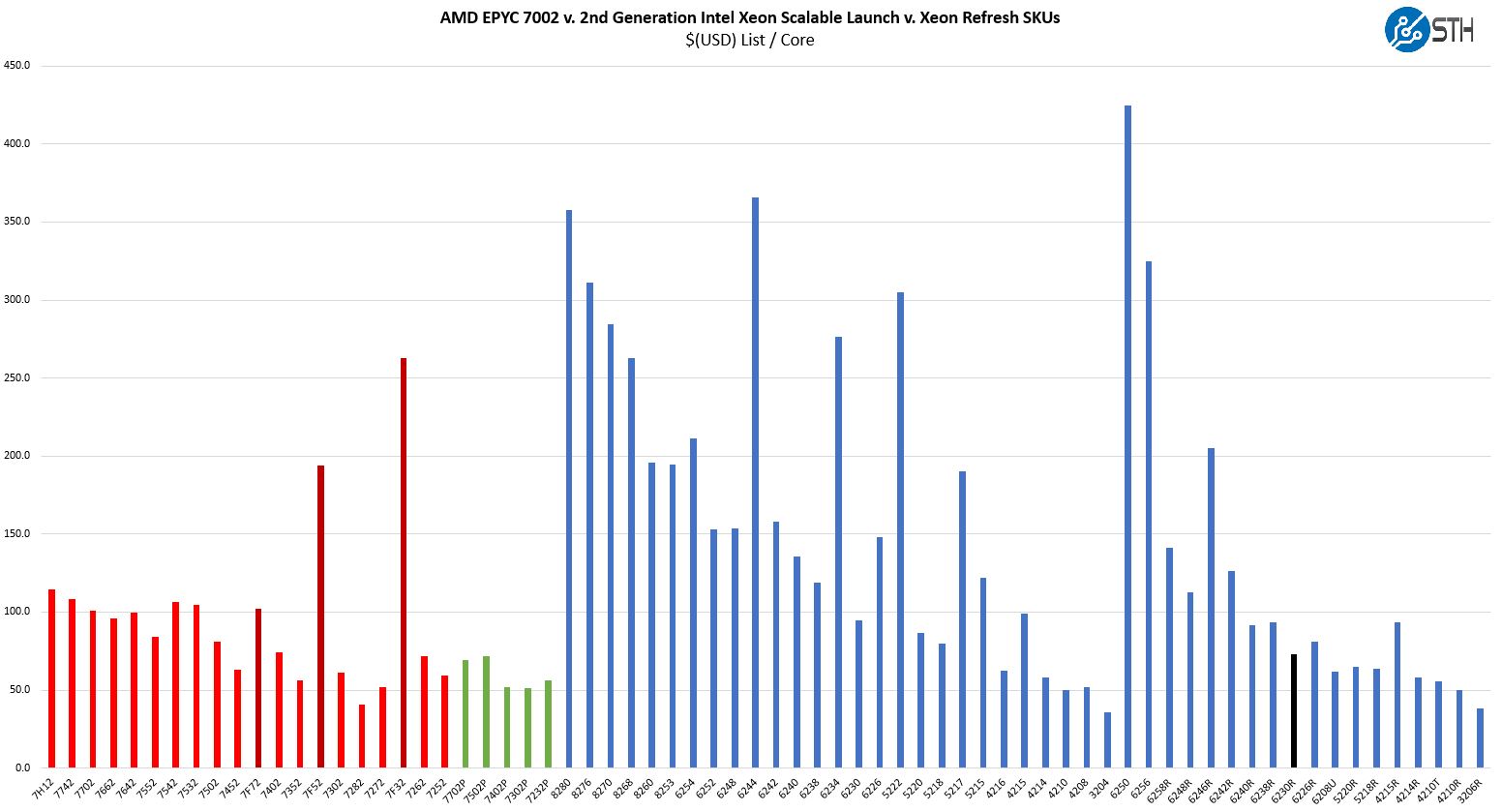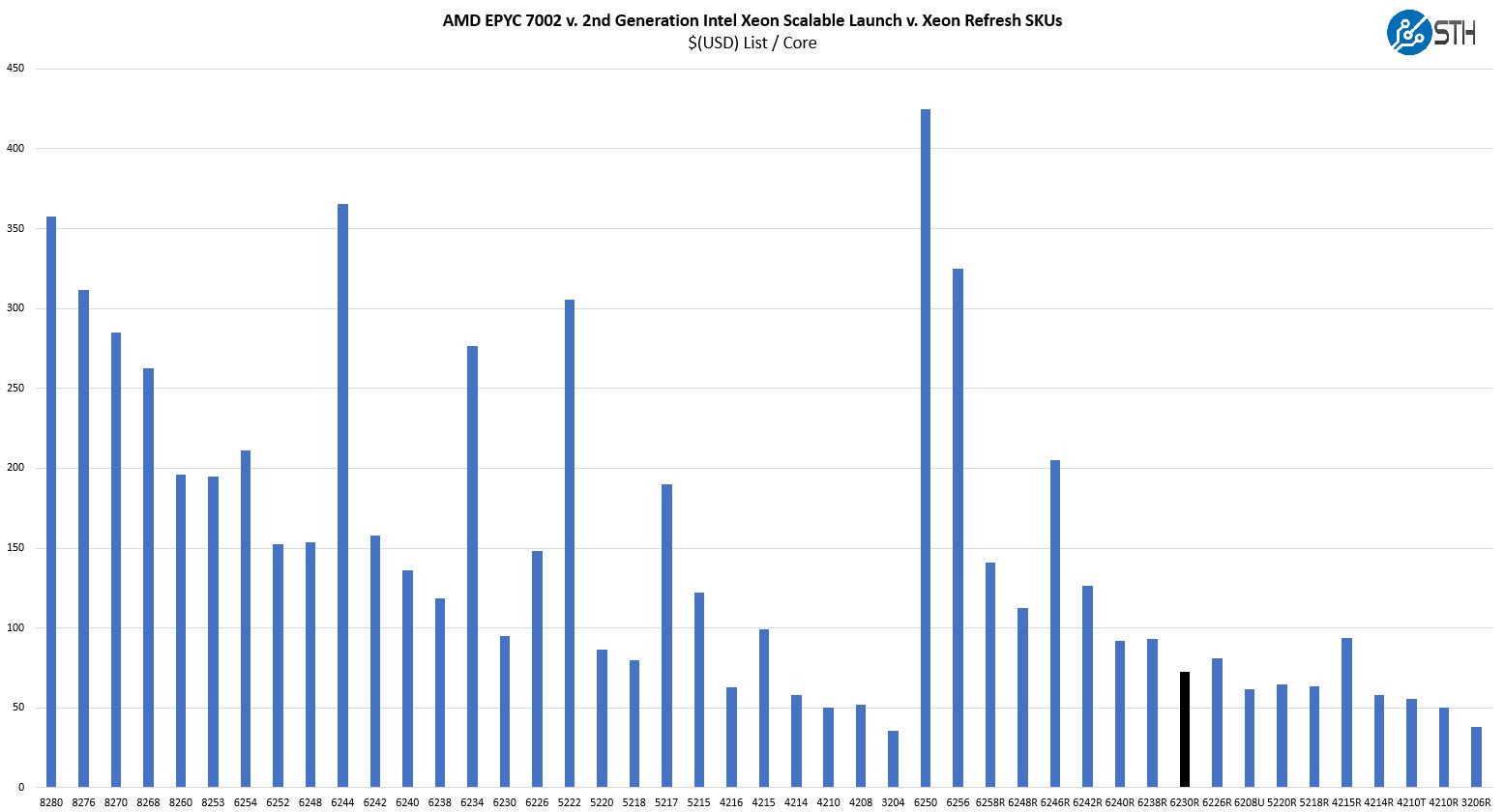Intel Xeon Gold 6230R Market Positioning
These chips are not released in a vacuum instead, they have competition on both the Intel and AMD sides. When you purchase a server and select a CPU, it is important to see the value of a platform versus its competitors. We are going to first discuss Intel v. AMD competition then look to Intel Xeon v. Intel Xeon.
Intel Xeon Gold 6230R v. AMD EPYC
Here we have the main segments of the AMD EPYC and 2nd Generation Intel Xeon Scalable processors on a $(USD) List per core basis:

At around $73 per core, the Xeon Gold 6230R is very competitive with AMD EPYC 7002 parts. Probably the closest two competitors, given this is not a frequency optimized part, to the Gold 6230R are the AMD EPYC 7352 and EPYC 7402. Those two SKUs are around $56 and $74 respectively. What Intel did with the refresh here are a few things. First, Intel can legitimately claim more cores in this pricing band. Second, Intel is close enough on a price/ performance basis to keep organizations from jumping to EPYC for that reason. When viewed from that level, AMD needed a “good enough” part and the Gold 6230R is exactly that.
AMD offers a larger memory footprint with up to 4TB in 8-channel DDR4-3200 versus 1TB in 6-channel DDR4-2933. AMD has more PCIe I/O with 64, 96, or 128 PCIe Gen4 lanes per socket compared to Intel’s 48x PCIe Gen3 lanes. Intel has features such as AVX-512 and VNNI instructions (DL Boost) that AMD does not have but are new for 2nd Generation Intel Xeon Scalable. Perhaps the biggest feature Intel has is Optane DCPMM support. We should note here that DCPMM support is limited by memory capacity since the Gold 6240R is not an “L” SKU. Still, if one wants fast storage, DCPMM is a significant option that AMD does not have. If you are not using small DCPMM footprints, nor the new instructions, then AMD is extremely competitive.
To us, building for a greenfield deployment it would be very hard to recommend the Gold 6230R over the EPYC 7352 or EPYC 7402 given the list pricing. Intel has a broad portfolio, albeit smaller with SK hynix Acquiring the Intel NAND Storage Business. As a result, we are only looking at CPUs here not deal priced platforms so there is some margin to play with. Also, given the 2nd Gen Xeon platforms are an aging generation of technology still with only PCIe Gen3 support, an advantage is that components such as motherboards, risers, and cables for these Xeon systems are a bit less expensive which neutralizes a lot of the cost delta.
At the high-end, with the AMD EPYC 7742 and AMD EPYC 7H12 Intel does not currently have a great competitive answer. In the Intel Xeon Gold 6230R range, which is more of the mainstream market, we see Intel as much more competitive at a system-level.
Intel Xeon Gold 6230R v. Intel Xeon
Intel made a strong competitive move in early 2020 with the Big 2nd Gen Intel Xeon Scalable Refresh altering the competitive landscape. Intel effectively dropped prices across most of its mainstream CPUs.
At around $73 per core, this SKU is on a different pricing model than other parts. For example, the previous public 26-core SKU was the higher-performance Platinum 8270 at $7,405 or around $285/ core. What would have been a more comparable pre-refresh part as the Intel Xeon Gold 6252 is almost twice the price for 24 cores at around $153/ core. Even generationally, the Xeon Gold 6230 was around $95/ core.

Something that is immediately obvious is that this part is priced aggressively on a cost-per-core basis. It is below that of the popular Intel Xeon Gold 5218. While it is not able to deliver per-core performance of some of Intel’s other offerings, with 26 cores and at this price band, it can be very attractive for those organizations looking for more cores per dollar in Intel’s stack.
Final Words
This is a somewhat challenging review given its timing. AMD has said its EPYC 7003 “Milan” generation is shipping to customers this quarter and general availability is next quarter. Intel has Ice Lake that is hitting customer trials now and will be launching in the first half of 2021 as we covered in the 2021 Intel Ice Pickle.
We are also comparing a 2017 architecture with security mitigations, an a removed feature (1x UPI) to what is on the market and it feels like we need a refresh.
At the same time, we recognize that budgets have time constraints and so a lot of servers will be purchased between now and the next-generation launch. Given that, this is actually a chip that we think has a lot of promise for the Intel Xeon Scalable stack. It is not too expensive and offers a lot of cores at a reasonable price. For software licensing purposes, the 24-core or other models may make more sense, consolidating performance to fewer cores. Still, there is a segment of the market that wants these lower power and higher core count parts where the Xeon Gold 6230R is a great value.



